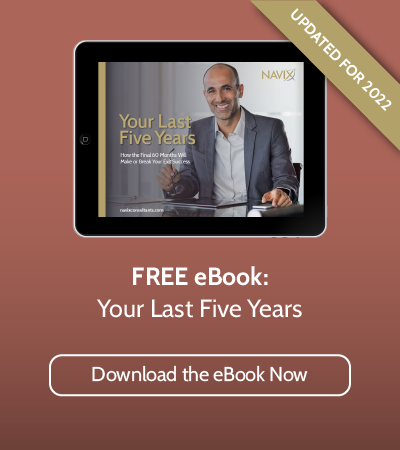By: Patrick Ungashick

Let me share with you three quick and true stories of business owners, and how each failed to achieve and maintain financial freedom at exit.
Story 1 - Joe
When I first met Joe, he was sitting in his desk chair, a broken man. He had sold his trucking company a couple of years earlier, expecting to fully retire. Joe had received some cash at closing, but a large portion of the deal included debt, financed by him. Shortly after selling, the economy had softened, and the new owner made some bad moves in the market. The company plummeted and defaulted on its payments to Joe. As a result, Joe had to take the business back. However, by then, the company was a shell of its former self, and market conditions stunk. To keep it afloat, Joe had to put back into the company much of the cash he had received at closing. Joe was tired. Joe was dejected. Joe was broken.
Story 2 – Neal
Neal was one of several partners in a convenience store company with locations across the midwestern US. Neal and his partners sold for $75 million. Neal netted about $15 million, and at the ripe old age of 50, he then had to find something else to do. We advised him to allocate $10 million to invest a new company while setting aside $5 million for safe, conservative investments. The $5 million, if allocated prudently, could provide for his family for the rest of their lives. Neal agreed with this recommendation. That is, until a few months later, when he purchased a manufacturing business for $30 million, putting all $15 million of his money into the deal.
Neal believed he had the Midas touch when it came to running a company, and he was confident this next one was a future gold mine. The seller also believed the company had a bright future, which is why he only sold Neal 75% of the company, keeping 25% for himself and agreeing to stay involved. Within weeks of the sale, Neal and his new partner were squabbling. Within months they were openly fighting. Lawsuits followed. Revenues fell as customers fled. Profits evaporated as key employees bailed. Neal ended up losing everything.
Story 3 – Dan
Dan was contacted out of the blue by a strategic buyer to acquire his garden equipment manufacturing company. At only $1 million in adjusted EBITDA, Dan’s company was fairly modest in size, but the buyer offered to pay ten times earnings in all cash at closing. Dan could not refuse. After paying off company debt and taxes, Dan walked away with about $5 million.
Entranced by selling for such a large multiple, Dan looked closely at his financial picture only after his exit. When he did, Dan realized that he could not conservatively invest the $5 million and maintain his family’s lifestyle for the rest of his life—he would run out of money. Dan’s three options were to: immediately find new work, cut his standard of living, or invest more aggressively. Dan chose the third option. He invested half of his funds into some raw land he intended to develop. His timing could not have been worse, for only a few months later, the real estate bubble burst. He also invested heavily in a local community bank, which eventually folded when a recession hit. Within a couple of years after selling this company, Dan owned some empty acres, some worthless bank stock, and a few hundred thousand dollars in cash.
Reaching Financial Freedom
All three of the business owners built fine companies. All three exited happily—or so they thought at the time that they exited. All three of them sold their companies for a compelling price. Also, unfortunately, all three of them failed to either achieve or maintain financial freedom.
Financial freedom is not just some buzz phrase, either to business owners or to us. We define it to mean reaching the state where working to generate income is a choice, rather than an economic necessity. Many business owners do not wish to ever fully retire. Entrepreneurs often see themselves “working” for nearly all their lives. Despite that, practically all business owners aspire to reach a point where work is a choice and not a necessity. That is financial freedom. It is the number one goal at exit for the vast majority of owners.
Unfortunately, many owners fail to reach financial freedom at exit, walking away with too little assets and income to meet the need. Other owners seem to have enough at exit only to make any one of several mistakes that set them back into a shortfall. Either way, if you find yourself coming up short, it will be too late to turn back the clock, and you will find yourself facing a list of undesirable choices.
There is only one sure way to reach financial freedom—you must create a valuable company and have a sound exit plan. Both elements are required. Just producing a valuable company is not enough (see the previous stories for evidence.) Building a valuable company without a sound exit plan is like rolling the dice with many chips on the table. You might win, and you might not. Why take that risk?
To help you reach financial freedom, you need a sound exit plan that addresses ALL of the following questions and issues:
- How valuable does your company need to be at exit?
- Are you on track to get there—and if not, what do you need to do about it?
- What makes one company more valuable at exit than another, and how can you maximize value in your company?
- How much money can you safely pull money out of your company between now and exit to reduce risk?
- What can you do to reduce taxes now and at your exit?
- How can you build and execute a post-exit financial plan that reduces risk and preserves financial freedom?
- What will you do in life after exit, and how can you make sure you don’t over-invest or risk too much?
Any exit plan that fails to address each of these issues, thoroughly and carefully, leaves you at risk, and you have worked too hard and achieved too much to come up short.
Our website is full of educational materials on this topic. To help you get started, consider the following free materials:
Cheat Sheet: “What Does an Exit Plan Look Like”
Free Ebook: “The Exit Magic Number™”
Free Webinar: “You Only Get One Shot”








